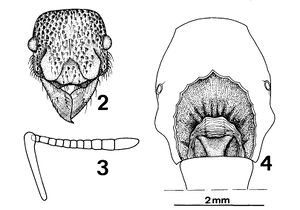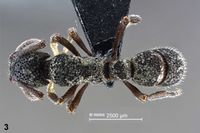Alfaria vriesi
| Alfaria vriesi | |
|---|---|

| |
| Scientific classification | |
| Kingdom: | Animalia |
| Phylum: | Arthropoda |
| Class: | Insecta |
| Order: | Hymenoptera |
| Family: | Formicidae |
| Subfamily: | Ectatomminae |
| Tribe: | Ectatommini |
| Genus: | Alfaria |
| Species: | A. vriesi |
| Binomial name | |
| Alfaria vriesi (Brandão & Lattke, 1990) | |
Specimens from Ecuador have abundant dirt and organic matter covering most of their body except for the cephalic and gastral ventral areas, implying foraging or nesting in the soil. These findings in southern Ecuador extend the range of this species by nearly 135 km to the South-West. (Lattke and Delsinne 2016)
Identification
Brandao and Lattke (1990) - This species is similar to Alfaria simulans and Alfaria falcifera, from which it differs in measurements (WL>3.0mm)and the following characters: anterior border of clypeus conspicuously concave; compound eyes bulging and with more than 20 facets in eye diameter, interrupting the head profile in full face view; metanotal groove deeper; propodeal spiracles circled by a conspicuous lighter band and bulging; propodeum declivity more deeply impressed; foramen circled by a raised margin; and anterodorsal margin of petiole raised.
The body surfaces of Alfaria simulans, Alfaria falcifera and Alfaria vriesi share a characteristic sculpturing; except for the legs, mandibles, anterolateral portions of frontal lobes and anterior portion of clypeus; very finely striolate and mostly covered by piligerous foveolae. In A. vriesi the fovolae are nearly contiguous and the stiolation can be seen only at high magnifications at the confluence of the depressions. From each foveola departs an eccentric hair, which is turned in different directions, depending on the area of the body. A. simulans and A. facifera may have extensive areas smooth and shining, but it A. vriesi the foveolae cover all body surfaces, except the cited ones. The holotype worker of the latter had these foveolae filled with earth, in a manner similar to that found by Holldobler and Wilson (1986) in Basiceros and Stegomyrmex (Myrmicinae).
The propodeal declivity in the three species bears a crested depression, completely sculptured with radiate punctations, clearly centered at the foramen in the new Ecuadorean species, but faintly visible in the previously described ones. These combined features distinguish these species from other taxa described as Alfaria and Gnamptogenys. They may be considered thus as forming a distinct subgroup of Alfaria.
Keys including this Species
Distribution
Latitudinal Distribution Pattern
Latitudinal Range: 3.13° to -11.0902027777778°.
| North Temperate |
North Subtropical |
Tropical | South Subtropical |
South Temperate |
- Source: AntMaps
Distribution based on Regional Taxon Lists
Neotropical Region: Ecuador (type locality).
Distribution based on AntMaps
Distribution based on AntWeb specimens
Check data from AntWeb
Countries Occupied
| Number of countries occupied by this species based on AntWiki Regional Taxon Lists. In general, fewer countries occupied indicates a narrower range, while more countries indicates a more widespread species. |

|
Estimated Abundance
| Relative abundance based on number of AntMaps records per species (this species within the purple bar). Fewer records (to the left) indicates a less abundant/encountered species while more records (to the right) indicates more abundant/encountered species. |

|
Biology
Morphology
Lattke and Delsinne (2016) - The eye structure in A. vriesi appears quite different from other Alfaria, and from most insects in general, by having the cuticle surrounding the eye forming a smooth, transparent convex structure, appearing as a single fishbowl-shaped lens with what seem to be very faint traces of individual facets formed by corneal lens, visible by SEM with a magnification of 180× and more. Corneal lens molded into individual facets are explicitly visible in both the reduced eyes of A. minuta and the large eyes of A. simulans. A compound eye with few, or an apparent single facet, is frequent in insects with reduced eyes (e.g., in Dorylinae; Werringloer 1932), but the bulging eyes of A. vriesi can hardly qualify as reduced. Separated beneath this fishbowl-like structure the apparent ommatidia are clearly visible. This state is shared not only by the present specimens but also by the holotype in the São Paulo Museum. Since the corneal lens is formed by the cuticle itself, this morphology opens questions such as is the crystalline cone separated from the corneal lens or is the corneal lens itself separated into different layers? Perhaps it is simply a postmortem artefact.
Castes
Described from workers and queen. Males are unknown.
Worker
  
| |
| . | |
Queen

| |
| . | |
The paratype queen is very similar to the worker holotype, though slightly smaller and with the normal caste differences, i.e., three ocelli (the posterior ones may be confused with the surrounding fovolae, but bear visible lenses), complete mesosoma with parapsidal sutures and the arm of the notalus. The extra tooth of each tarsal claw is less developed in the queen than in the worker.
Nomenclature
The following information is derived from Barry Bolton's Online Catalogue of the Ants of the World.
- vriesi. Gnamptogenys vriesi Brandão & Lattke, 1990: 490, figs. 1-7 (w.q.) ECUADOR.
- Type-material: holotype worker, 1 paratype queen.
- Type-locality: holotype Ecuador: Morona-Santiago Prov., Los Tayos (3°08’S, 78°14’W), 3.vii.1976, no. VIII-4 (T. de Vries); paratype with same data but no. I-16.
- Type-depository: MZSP.
- Combination in Alfaria: Camacho, Franco, Branstetter, et al. 2022: 10.
- Status as species: Brandão, 1991: 345; Lattke, 1992a: 128; Bolton, 1995b: 211; Lattke, et al. 2007: 264 (in key); Lattke & Delsinne, 2016: 142 (redescription); Camacho, et al. 2020: 462 (in key); Camacho, Franco, Branstetter, et al. 2022: 10.
- Distribution: Brazil, Ecuador.
Unless otherwise noted the text for the remainder of this section is reported from the publication that includes the original description.
Description
Worker
Lattke and Delsinne (2016) - HL 1.95, HW 1.87 (posterad to eye), SL 1.77, ED 0.35, WL 3.03, PL 1.23 (in dorsal view); CI 0.96, SI 0.95, OI 0.19. Specimen 2: HL 1.93, HW 1.82, SL 1.84, ED 0.36, WL 3.00, PL 1.20; CI 0.94, SI 0.95, OI 0.18.
Head subquadrate in full face view; posterior cephalic margin straight, lateral margin straight to weakly convex; anterolateral cephalic margin slightly bulging. Frons with a median longitudinal slit that extends from the supraclypeal area to the height of the eye posterior margin. Eye semi-spherical, placed close to cephalic mid-length; frons with abundant foveolae, diameter of each depression usually greater than width of intervening space. Each foveola with an eccentric hair, which turned in different directions, depending on the area of the head. Integument between depressions very finely striate with silky sheen; bottom of foveolae with more impressed and more spaced strigae. Clypeal disc smooth with some foveolae, frontal lobe foveolate and silky mesad but toward lateral margin without depressions, mostly smooth with weak striae. In dorsal view, frontal lobe greatly expanded laterad, covering all of scape base, including condyle and neck. Mandible shining, triangular and elongate, longitudinally striate with an edentate masticatory margin. Palps not visible.
Anteromedian clypeal margin concave, overhanging lateral clypeal margin, which is concave mesad and convex laterad. No anterior clypeal lamella. Antennal scape projects beyond posterior cephalic margin by at most one-fourth its length, shining with fine longitudinal striae and punctures at the base of abundant suberect white to golden hairs. In lateral view occipital lobe well-developed, with bluntly angular ventral margin. Cephalic ventrum also foveolate, with intervening space covered with longitudinal or transverse striae more impressed than on the dorsal area. Anterior part of hypostome forms small blunt projection. Compound eye round, semispherical with smooth and transparent outer surface, physically separated from convex grouping of apparent ommatidia by a space.
Mesosomal dorsal margin in lateral view with promesonotum forming one convexity and propodeum another; promesonotal suture not visible; metanotal groove clearly impressed. Cuticle silky with dense piligerous foveolae, progressively vanishing on metapleuron. Pronotum anterolaterally with depression that mirrors cephalic occipital lobe. Mesometapleural suture well-impressed, anepisternum clearly separated from katepisternum. Metapleural gland opening forming a transverse slit. Bulla distinct as low swelling. Propodeal spiracle slightly bulging, round, surrounded by light brown rim, and separated from posterior margin by one diametre or less. Propodeal declivity opaque, very finely granulose with hints of striolae; surrounded by lamellate, inverted U-shaped crest.
Petiolar node relatively low and evenly convex, without differentiated posterior face, foveolate; anteroventral process of petiole shaped as low rounded lobe. Postpetiolar ventral margin sinuate in lateral view, a longitudinal crest extends from prora to posterior margin of abdominal sternite III; dorsal margin mostly weakly convex in lateral view, most convex posterad. Cinctus present between petiole and abdominal segment III, and between abdominal segment III and IV. Abdominal segment IV with dorsal margin extremely convex, bulging such that apex faces anteroventrally; sternite IV convex. Abdominal sternites IV to apex form concavity in lateral view. Gaster mostly foveloate, shallow on abdominal sternite III. Body dark brown with abundant white to golden stiff hairs; welldeveloped sting. Hindcoxa with low, blunt, and outward projected tubercle. Coxae with transverse striolae, femora dorsally longitudinally striolate, ventrally transverse, tibiae longitudinally striolate. One simple spur each on meso- and metatibiae. Claws with well-developed basal tooth.
Type Material
Types: Worker (holotype) and dealated queen (paratype) collected at Ecuador: prov. Morona-Santiago: Los Tayos (03 08'S, 78 14'W) 3 July 1976 by Tjitte de Vries. Collection numbers VIII-4 (holotype) and I-16 (paratype). Holotype and paratype deposited at Museu de Zoologia da Universidade de Sao Paulo (MZSP).
Etymology
The specific name is a patronym in honor of Tjitte de Vries who collected the types.
References
- Brandão, C. R. F.; Lattke, J. E. 1990. Description of a new Ecuadorean Gnamptogenys species (Hymenoptera: Formicidae), with a discussion on the status of the Alfaria group. J. N. Y. Entomol. Soc. 98: 489-494.(page 490, figs. 1-7 worker, queen described)
- Camacho, G.P., Franco, W., Branstetter, M.G., Pie, M.R., Longino, J.T., Schultz, T.R., Feitosa, R.M. 2022. UCE phylogenomics resolves major relationships among Ectaheteromorph ants (Hymenoptera: Formicidae: Ectatomminae, Heteroponerinae): A new classification for the subfamilies and the description of a new genus. Insect Systematics and Diversity 6(1): 5; 1–20 (doi:10.1093/isd/ixab026).
- Lattke, J.E. & Delsinne, T. 2016. Revisionary and natural history notes on some species of the genus Gnamptogenys Roger, 1863. Myrmecological News 22: 141-147.
- Lattke, J.E., Fernández, F. & Palacio, E.E. 2007. Identification of the species of Gnamptogenys Roger in the Americas (pp. 254-270). In Snelling, R.R., Fisher, B.L. & Ward, P.S. (eds). Advances in ant systematics: homage to E.O. Wilson – 50 years of contributions. Memoirs of the American Entomological Institute 80: 690 pp.
References based on Global Ant Biodiversity Informatics
- Brandão, C.R.F. and J.E. Lattke. 1990. Description of a new Ecuadorean Gnamptogenys species (Hymenoptera: Formicidae), with a discussion on the status of the Alfaria group. Journal of the New York Entomological Society 98(4):489-494.
- Fernández F., and T. M. Arias-Penna. 2008. Las hormigas cazadoras en la región Neotropical. Pp. 3-39 in: Jiménez, E.; Fernández, F.; Arias, T.M.; Lozano-Zambrano, F. H. (eds.) 2008. Sistemática, biogeografía y conservación de las hormigas cazadoras de Colombia. Bogotá: Instituto de Investigación de Recursos Biológicos Alexander von Humboldt, xiv + 609 pp.
- Fernández, F. and S. Sendoya. 2004. Lista de las hormigas neotropicales. Biota Colombiana Volume 5, Number 1.
- Lattke J. E., and T. Delsinne. 2016. Revisionary and natural history notes on some species of the genus Gnamptogenys Roger, 1863 (Hymenoptera: Formicidae). Myrmecological News 22: 141-147.
- Lattke, J.E. 1992. Revision of the minuta-group of the genys Gnamptogenys. Dtsch. ent. Z., N.F. 39:123-129
- Scott-Santos, C.P., F.A. Esteves, C.R.F. Brandao. 2008. Catalogue of "Poneromorph" ant type specimens (Hymenoptera, Formicidae) deposited in the Museu de Zoologia da Universidade de Sao Paulo, Brazil. Papeis Avulsos de Zoologia 48(11):75-88.

